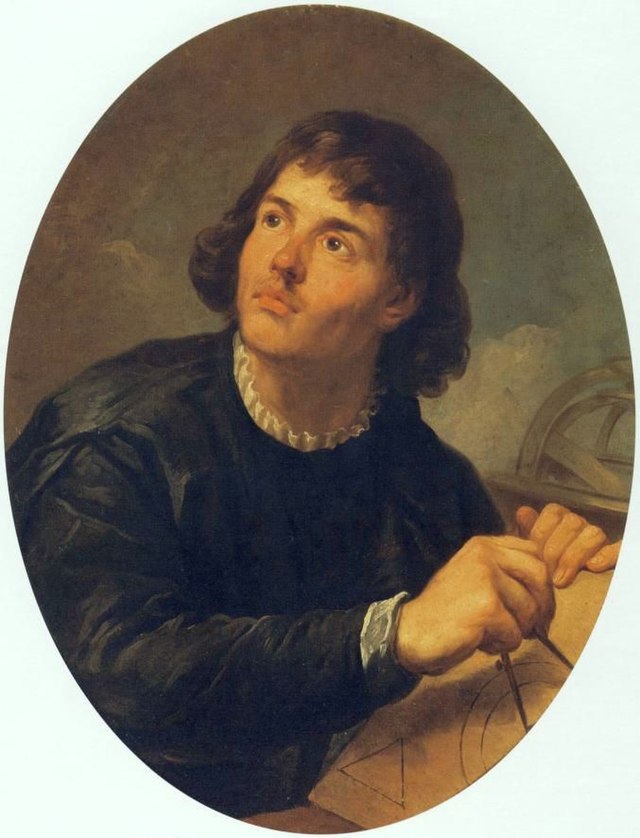Nicolaus Copernicus
Nicolaus Copernicus (19 February 1473 – 24 May 1543) was a Renaissance polymath, active as a mathematician, astronomer, and Catholic canon, who formulated a model of the universe that placed the Sun rather than Earth at its center. In all likelihood, Copernicus developed his model independently of Aristarchus of Samos, an ancient Greek astronomer who had formulated such a model some eighteen centuries earlier.
The publication of Copernicus' model in his book De revolutionibus orbium coelestium (On the Revolutions of the Celestial Spheres), just before his death in 1543, was a major event in the history of science, triggering the Copernican Revolution and making a pioneering contribution to the Scientific Revolution.
Biography
Copernicus was born and died in Royal Prussia, a region that had been part of the Kingdom of Poland since 1466. A polyglot and polymath, he obtained a doctorate in canon law and was a mathematician, astronomer, physician, classics scholar, translator, governor, diplomat, and economist. In 1517 he derived a quantity theory of money—a key concept in economics—and in 1519 he formulated an economic principle that later came to be called Gresham's law.
Some time before 1514 Copernicus made available to friends his "Commentariolus" ("Little Commentary"), a manuscript describing his ideas about the heliocentric hypothesis. It contained seven basic assumptions. Thereafter he continued gathering data for a more detailed work.
At about 1532 Copernicus had basically completed his work on the manuscript of Dē revolutionibus orbium coelestiumm; but despite urging by his closest friends, he resisted openly publishing his views, not wishing—as he confessed—to risk the scorn "to which he would expose himself on account of the novelty and incomprehensibility of his theses."
In 1533, Johann Albrecht Widmannstetter delivered a series of lectures in Rome outlining Copernicus's theory. Pope Clement VII and several Catholic cardinals heard the lectures and were interested in the theory. On 1 November 1536, Cardinal Nikolaus von Schönberg, Archbishop of Capua, wrote to Copernicus from Rome:
"Some years ago word reached me concerning your proficiency, of which everybody constantly spoke. At that time I began to have a very high regard for you... For I had learned that you had not merely mastered the discoveries of the ancient astronomers uncommonly well but had also formulated a new cosmology. In it you maintain that the earth moves; that the sun occupies the lowest, and thus the central, place in the universe... Therefore with the utmost earnestness I entreat you, most learned sir, unless I inconvenience you, to communicate this discovery of yours to scholars, and at the earliest possible moment to send me your writings on the sphere of the universe together with the tables and whatever else you have that is relevant to this subject ..."
By then Copernicus's work was nearing its definitive form, and rumors about his theory had reached educated people all over Europe. Despite urgings from many quarters, Copernicus delayed publication of his book, perhaps from fear of criticism—a fear delicately expressed in the subsequent dedication of his masterpiece to Pope Paul III. Scholars disagree on whether Copernicus's concern was limited to possible astronomical and philosophical objections, or whether he was also concerned about religious objections.
De revolutionibus orbium coelestium
Copernicus was still working on De revolutionibus orbium coelestium (even if not certain that he wanted to publish it) when in 1539 Georg Joachim Rheticus, a Wittenberg mathematician, arrived in Frombork. Philipp Melanchthon, a close theological ally of Martin Luther, had arranged for Rheticus to visit several astronomers and study with them. Rheticus became Copernicus's pupil, staying with him for two years and writing a book, Narratio prima (First Account), outlining the essence of Copernicus's theory.
In 1542 Rheticus published a treatise on trigonometry by Copernicus (later included as chapters 13 and 14 of Book I of De revolutionibus). Under strong pressure from Rheticus, and having seen the favorable first general reception of his work, Copernicus finally agreed to give De revolutionibus to his close friend, Tiedemann Giese, bishop of Chełmno (Kulm), to be delivered to Rheticus for printing by the German printer Johannes Petreius at Nuremberg (Nürnberg), Germany. While Rheticus initially supervised the printing, he had to leave Nuremberg before it was completed, and he handed over the task of supervising the rest of the printing to a Lutheran theologian, Andreas Osiander.
Osiander added an unauthorised and unsigned preface, defending Copernicus' work against those who might be offended by its novel hypotheses. He argued that "different hypotheses are sometimes offered for one and the same motion [and therefore] the astronomer will take as his first choice that hypothesis which is the easiest to grasp." According to Osiander, "these hypotheses need not be true nor even probable. If they provide a calculus consistent with the observations, that alone is enough."
